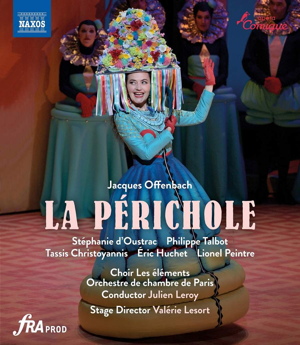
Jacques Offenbach (1819-1880)
La Périchole, opéra bouffe in three acts (1874)
Book by Ludovic Halevy & Henri Meilhac
Stéphanie d’Oustrac (mezzo soprano) – La Périchole; Philippe Talbot (tenor) – Piquillo; Tassis Christoyannis (baritone) – Don Andrès de Ribeira; Eric Huchet (tenor) – Don Miguel de Panatellas; Lionel Peintre (baritone) – Don Pedro de Hinoyosa
Choeur Les éléments
Orchestre de chambre de Paris/Julien Leroy
rec. 17 & 19 May 2022, Opéra-Comique, Paris, France
Naxos NBD0168V Blu-ray [219]
It is not often that one can be so impressed with the visuals of a modern production, but this production makes one sit up and take note of it. Given the fun that always seems to be close to the surface of Offenbach productions, I was in the mood to accept surrealism, elements of pantomime and a sun-baked, exuberant presentation. That said, I had to admire the creation of elements of Peru and Spain in the settings and costumes – for this opéra bouffe is set in Lima. Classic Parisienne choreography is also wedded to the action. The visual effect is stunning, and is enhanced by Christian Pinaud’s co-ordinated lighting. This creativity must be the result of a close working relationship between Valérie Lesort’s direction, and the costume and choreography teams. I love their subtleties that bring out nuances of interest that could otherwise be unobserved.
The original production, in a two-act version, was staged in 1868 at the Théâtre des Variétés before being revised and represented in this three-act version in 1874 at the Opéra-Comique, Paris.
The cast line-up is excellent and the portrayals of street entertainers La Périchole and Piquillo are brilliant. I like Stéphanie d’Oustrac’s velvety mezzo as La Périchole and Philippe Talbot’s bright tenor with its elegant vibrato. Both command a strong stage presence — in fact the whole company expends considerable energy in creating adorable stage pictures with flamboyant choreography. The police with their geometric outfits and hats cleverly twist and turn to give different visual effects, as do the dresses of concentric circles (not far removed from the Michelin Man) that open Act II. I particularly like the transformation by three girls who hang their heads and long hair down to mimic horses’ tails so that the police can ride them. Elsewhere, there is juggling and a puppet display appropriate to a French circus. It all fits the scheme of things and enhances Offenbach’s music.
The eccentric and surrealist design of the costumes may look quirky, but the more you study them their subtleties dawn. One needs to accept that the presentation is pantomimic where the focus is on spectacle – and what a feast of colour and design we have. Audrey Vuong’s settings are delightful. The Spanish style is decorated with Peruvian detail in muted tones that do not try to ‘upstage’ the magnificent costumes of intense colour. Only the narrow balustrades to the side steps seemed crudely unconvincing to the eye.
This production displays an expected high level of technical competence in vision and sound, as found in recent Naxos productions. The chapter cues I find are very accurately set. More important, perhaps, are the good television shot angles and interesting cutaways under the vision control of Francois Roussillon (who is unusually credited as ‘Film Director’).
This has to be a benchmark production of Offenbach’s important oeuvre and it maintains the high quality found in other Opéra-Comique productions. An older, but good, CD recording with dialogue on EMI also exists, reviewed here. It was of interest to find out that this opéra bouffe achieved only 98 performances when originally staged in 1874. It deserved more, despite successfully travelling round Europe and coming to London’s Royalty Theatre in 1875.
The is sung in French and the notes and subtitles are in French and English. Sound formats include surround sound.
Raymond J Walker
Help us financially by purchasing from





















